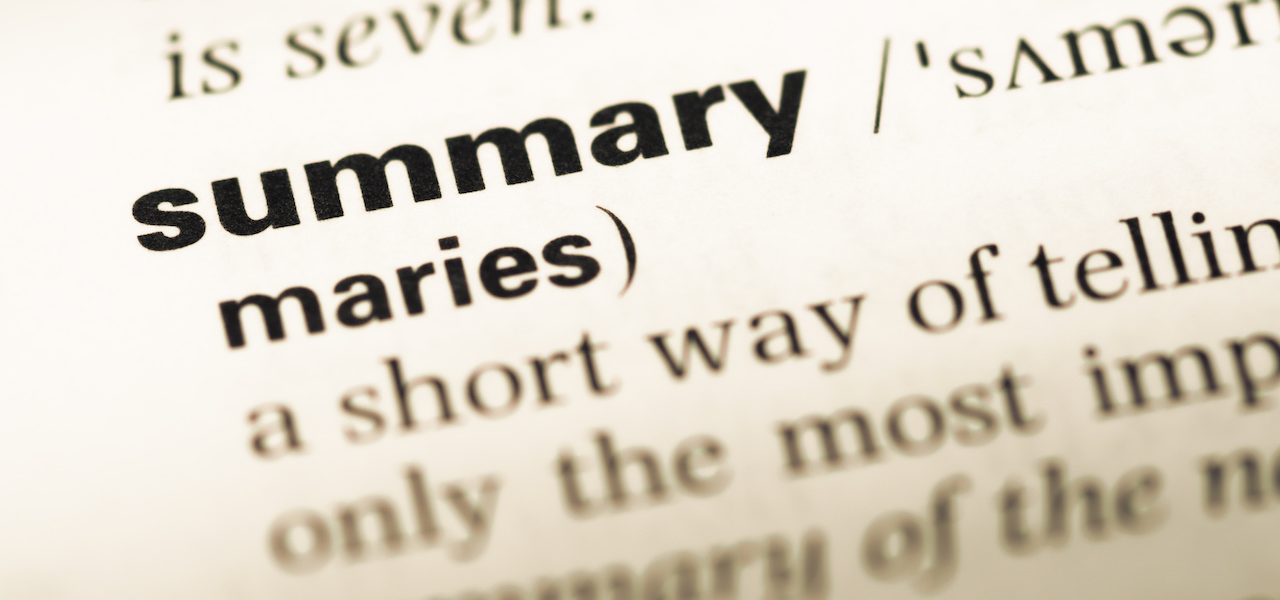IF SCENE IS THE BUILDING BLOCK of story, summary is the glue that links and holds scenes together.
To understand how scene and summary work together, it’s important to understand the difference between the two methods.
A brief definition of scene.
Scene always takes place in a specific place and time. For example, it’s 9:00 a.m. on a Sunday morning in a small coastal town. The sky is overcast, threatening rain. Surging waves, pushed inland from a storm miles out at sea, are crashing mercilessly against the rocks, while your character stands on the cliff’s edge, weighing his options. The action takes place within this specific time and at this specific place, providing a sense of immediacy.
A well-written scene allows us to climb inside the characters’ heads and see, hear, smell, taste, and feel the world through their bodies. And while it’s true that we aren’t actually experiencing the stories through the senses, our imaginations are so potent and powerful, that it is every bit as if we were. Studies have shown that when we imagine smells, for example, the same areas of the brain lights up as when inhaling the real thing.
Scene expands time, slows it down, and focuses on a specific situation and set of actions, so you can see the waves and rocks and scuttling sand crabs through your main character’s eyes and feel the ocean breeze through his skin.
Our brains do not understand the difference between real and imagined experiences, which explains why well-written scenes can cause our hearts to pound and emotions to rise.
A brief definition of Summary
Summary, on the other hand, condenses a period of time into a paragraph or two, or perhaps a sentence. For example, “When we were children, my brothers and I used to play in the grassy fields and hills near our home” summarizes an entire childhood. Condenses years into a sentence.
Summary doesn’t do away with sensory detail, but condenses it, uses it sparingly, and focuses on habitual, not specific, actions or situations.
Examples
Take the following short passage from Barbara Kingsolver’s novel, The Poisonwood Bible, in which we learn about the narrator’s father. This summary passage reveals key aspects of his character through his actions, covering the years from when he was a child to young adult in just a few sentences.
My father believes in enlightenment. As a boy he taught himself to read parts of the Bible in Hebrew, and before we came to Africa he made us all sit down and study French, for the furtherance of our mission. He has already been in so many places, including another jungle overseas, in the Philippine Islands, where he was a wounded hero in the Second World War. So he’s seen about everything.
Contrast that summary with this scene excerpt, which also reveals a great deal about the narrator’s father:
He beat down a square of tall grass and wild pink flowers, all without once ever looking at me. Then he bent over and began to rip out long handfuls of grass with quick, energetic jerks as though tearing out the hair of the world. He wore his cuffed, baggy work khakis and a short-sleeved white shirt, and labored at the center of a rising red cloud of dust like a crew-cut genie who’d just appeared there. A fur of red dust gathered on the curly hairs of his forearms, and rivulets of perspiration ran down his temples. The tendon of his jaw was working, so I knew he was preparing a revelation.
Do you see the difference?
Summary provides an overview, a picture of a situation as from a distance; it’s like looking at an aerial video of a town — you can see the houses and churches and roads, giving you a strong sense of the place, but the cars and people are tiny moving dots in the picture, and you can’t really experience the action.
Scene places us in the middle of a situation; in this analogy, it’s like zooming into a particular house in the town and sitting down to dinner with the family who lives there. Scene provides an intimate view of the action.
Let’s look at another example and contrast of scene and summary, this time from a memoir: Imperfect Endings: A Daughter’s Story of Love, Loss, and Letting Go, by Zoe FitzGerald Carter
In this scene, the narrator is at the dining table with her family. Her sister and father are arguing.
I watched, halfway out of my seat, as she lived the plate and threw it down on the table, shattering it. The pieces of plate were stuck under the gluey strands of spaghetti so they didn’t go very far, but the sound was like someone’s head cracking.
–We all stood there, waiting for the next thing to happen. My father moved first. He reached out and slapped Katherine, hard, right across the face. She turned and darted behind him. She grabbed the fire poker hanging next to the fireplace and swung it at him. . .
The action is immediate. We are in the room with the narrator, experiencing the action and emotion as it unfolds.
In the same memoir, in this bit of summary, the narrator has just finished relating the story of how her mother and father met, as told to her by her parents.
It was only later that I came to understand how much more they must have seen and understood about each other during that fateful encounter in Mitzy’s kitchen.
–Here was my father, a middle-class, midwestern boy, new to New York City, face-to-face with my glamorous aristocratic-looking mother . . .
–This was not my father’s background. His own father was a farm boy from Illinois who had attended the University of Illinois on a scholarship. My grandfather’s first job was in the mail room of a machinery company in Chicago that made industrial cranes. Quickly moving through the ranks, he ended up as a president of the company. It was a real pull-yourself-up-by-your-bootstraps, American success story that included a second home on the shores of Lake Michigan and a son at fancy East Coast private schools.
This passage sums up the grandfather’s working life and family’s social status, all in one fell swoop. The summary goes on, describing her father over the years, providing a picture of the man as seen through the narrator’s eyes from the distance of time. Action is not immediate, but habitual and typical. Imagine trying to portray all this detail using scenes. The book would be twice as long, and we’d have a bunch of scenes involving the grandfather and father that would be irrelevant to the core of the story the narrator is telling.
So when should you use scene and when should you use summary?
- Use scene to portray important moments, actions, conflicts, characters, and consequences.
– - Scene should be the major component of your story.
– - Use summary to provide backstory elements and important details that will enhance character, place, or a character’s perspective.
– - Summary can also be used to speed through time, fast forwarding and linking scenes that are separated by years.
– - Summary should be used sparingly. A story told entirely in summary would be too fast, not experiential enough, and would bore your readers by its emotional distance.
In conclusion, not every detail of a story needs to be portrayed in scene. Summary allows you to vary and control pace. It speeds up the story, providing contrast to the experiential detail and action that moment-by-moment scene provides.
Using the film analogy, summary zooms out, giving us an overview of a character, time or place, while scene zooms in to a specific place and time, allowing us to experience the story viscerally and from your character’s point of view. Use both scene and summary to vary the pace and engage your readers while providing background details important to your story.
What challenges you most about writing scene or summary?







Thanks ever so much, Amber. I appreciate having such a visual to see and understand the importance of summarizing a scene. Quite helpful! Know I appreciate your unselfish and compassionate contribution to the world of writing. Enjoy your week!
Thank you Amber! I am RIGHT NOW in the midst of creating scene and dialogue in my memoir.
This was very helpful. I am noticing how much I am using scene and how often I use summary.
I have much to learn, but now, on my second draft this part is actually challenging and ‘fun’.
Thanks for this post!
Pingback: Writing Craft: How to Control Your Story’s Pace – Writing Through Life
Pingback: How to Transform Exposition and Summary into Scene – Writing Through Life